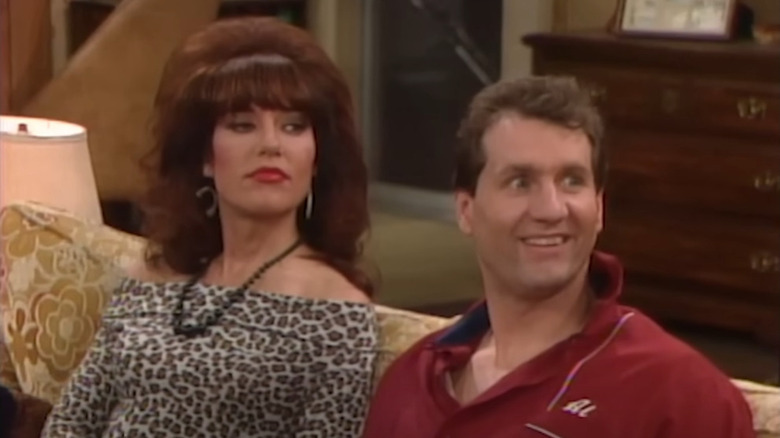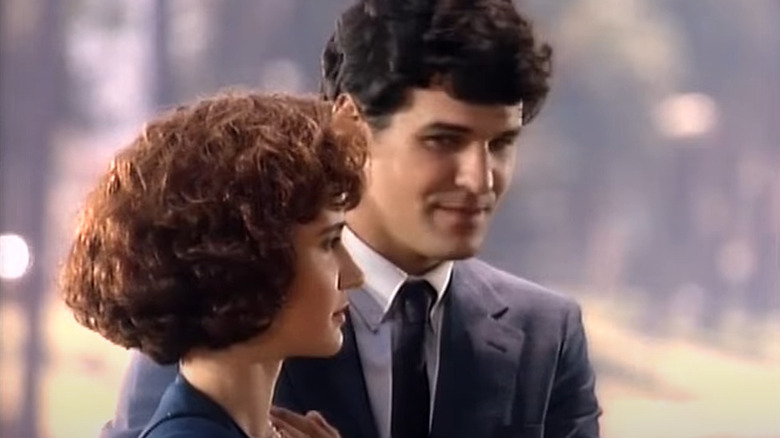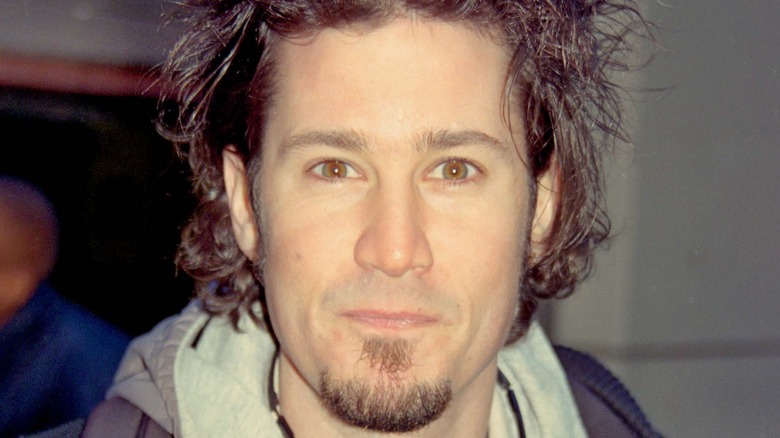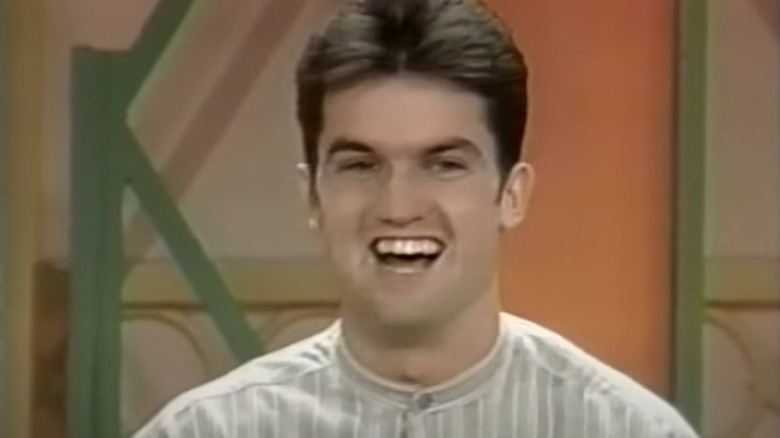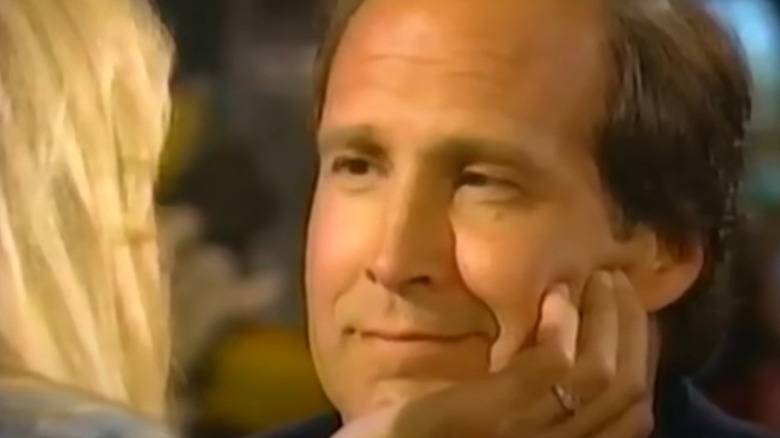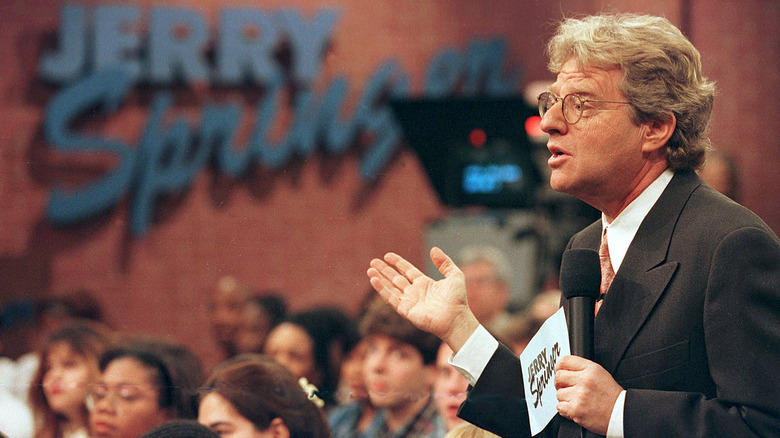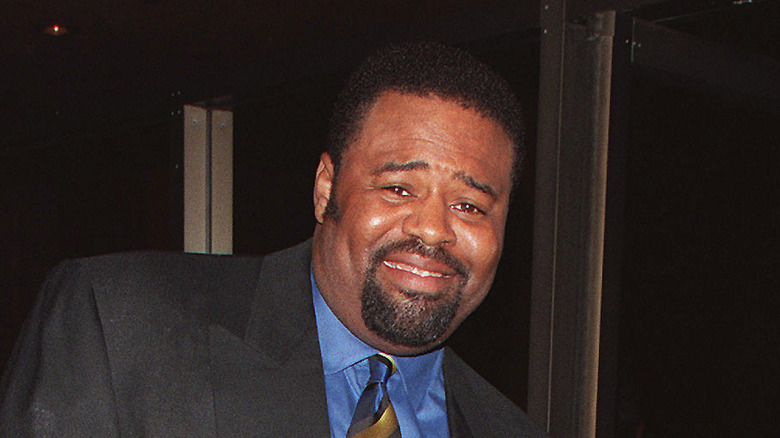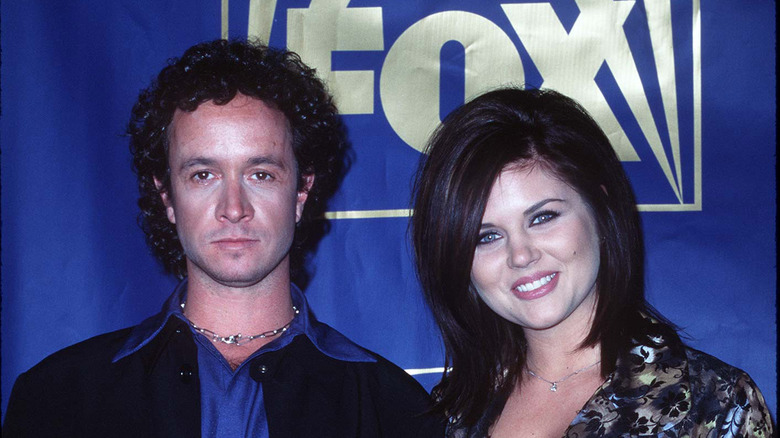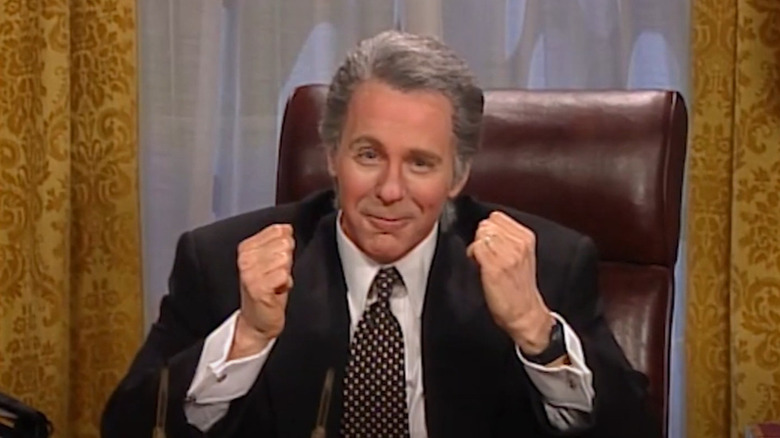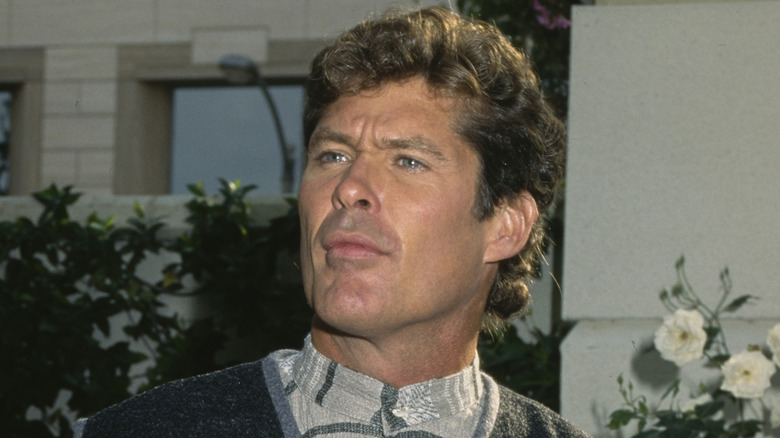'90s TV Train Wrecks You Forgot About
The 1990s were a particularly momentous time in the world of television. NBC's "Must See TV" ruled primetime following the 1994 introduction of Ross, Rachel, Chandler, Monica, Joey, and Phoebe on "Friends," as well as the reintroduction of Dr. Frasier Crane in the "Cheers" spin-off "Frasier" a year earlier, and the rise to prominence of "Seinfeld." Meanwhile, Bill Clinton played his saxophone on "The Arsenio Hall Show," "Baywatch" became an international sensation, the WB reinvented the teen drama with "Dawson's Creek" and "Buffy the Vampire Slayer," and, on June 17, 1994, an NBA Finals broadcast was interrupted as an estimated 95 million people watched O.J. Simpson and his friend, Al Cowlings, evade police in a white Bronco following the murder of Nicole Brown Simpson.
However, there were also shows that rattled the wrong cages or flopped entirely, and happenings both in front of and behind the cameras that ended in heartbreak and scandal. In other words, for every hit show or history-making moment, there was a television train wreck that played out before our very eyes. Here are some of the biggest misfires and/or bad moments of the decade.
A Michigan mom led a boycott of Married... with Children that cost the show sponsors
The stakes were high when the Fox network hit the airwaves for the first time in the late 1980s. For decades, broadcast television had been dominated by the Big Three networks: ABC, CBS, and NBC. Despite the uphill battle, though, Rupert Murdoch's fledgling network was able to steal viewers from the more established broadcasters, thanks in large part to the appeal of early hits "Married... with Children," "The Tracey Ullman Show" (where "The Simpsons" made their debut as animated shorts), and "21 Jump Street." Over the years, "Married... with Children" has come to exemplify that early battle for relevance and surprise success, as its raunchy humor, sharp writing, and star-making performances from Ed O'Neill, Katey Sagal, and Christina Applegate captured the imagination of the mainstream masses.
However, the program's racy content, which included many moments that simply would not fly today, drew the ire of family advocacy groups and individuals with more conservative viewing habits, including Michigan mom Terry Rakolta, who led a boycott against "Married... with Children" in 1989 and 1990. Her movement was successful to a degree, too. Tambrands Inc., the maker of Tampax, reportedly stopped advertising with the network, while other sponsors cut back on their own advertising during the show. In the end, Rakolta's activities may have been the real train wreck; the show continued to air on Fox until 1997 and enjoyed a large viewership, the boycott and sponsor drama notwithstanding.
Cop Rock was a musical-procedural drama misfire
Sometimes a concept for a television show or film is so bizarre, so out of place alongside its contemporaries, that it must be seen to be believed. Such was the case with the short-lived ABC musical procedural drama "Cop Rock." Created by Steven Bochco and William M. Finkelstein, "Cop Rock" chronicled the fictional exploits of law enforcement officials with the Los Angeles Police Department; it was like "L.A. Law" or "Hill Street Blues," if those shows had also been like "Grease" or "Mamma Mia!" with their characters spontaneously breaking out into song in regular intervals. The idea was so strange, in fact, that composer Mike Post tried to convince Bochco to abandon the project. "I said, 'No, Steven, I'm telling you this is too hard. This is too f***ing hard!' I said to him, 'America is not ready for the cops singing. They're not ready for that,'" Post said of the phone call he received from Bochco pitching the idea, via The Hollywood Reporter.
Post may have been right. Seven episodes in, ABC decided to pull the plug on the show amid low ratings (four more episodes would air before its final curtain call). The show is remembered now as one of those beautiful disasters that's so bad that it's actually kind of good. Legendary singer-songwriter Randy Newman even captured an Emmy for writing some of the show's music. However, its memeable songs are undoubtedly its enduring legacy.
Herman's Head became a cult classic, but it's still a total trainwreck
As evidenced by "Cop Rock," television train wrecks can still be memorable and/or entertaining, and cult classic "Herman's Head" may just be one of those. Like "Married... with Children" and "The Simpsons," "Herman's Head" was one of the sitcoms that the Fox network aired during its first few years of existence in the hopes that a watcher or two could be plucked from the Big Three. However, it lacked the mass appeal that those and some of Fox's other, more successful programs had. Starring William Ragsdale as Herman Brooks, the show followed the adventures of a fact-checker/single guy as he navigated life and romance in Manhattan. The twist was that the show also featured characters meant to represent the emotions occupying Herman's psyche; think "Inside Out" but as a raunchy, early '90s sitcom.
The series was a dud with critics, but it managed to hang around for three seasons before meeting the chopping block. Still, it featured the talents of "Simpsons" alums Yeardley Smith and Hank Azaria, and there were some clever kernels there, as evidenced by the success of "Inside Out's" more approachable execution of the concept.
A segment from The Jenny Jones Show resulted in a man's murder and scandal for the daytime hit
One could argue that syndicated daytime talk shows were at their peak during the 1990s, during which the likes of Oprah Winfrey, Phil Donahue, Sally Jessie Raphael, Jenny Jones, Maury Povich, Montell Williams, Geraldo Rivera, Ricki Lake, and even Jerry Springer had popular shows. That said, some of these series veered hard toward the sensational, with adult undertones and controversial topics. In most cases, the segments featuring tabloid themes and weird/wild guests were relatively harmless. However, a segment from an unaired March 1995 episode of "The Jenny Jones Show" titled "Revealing Same Sex Secret Crush" ended up having deadly consequences when one of the guests couldn't deal with what transpired on the show.
Detroit-area waiter Jon Schmitz had been told by the show's producers that he had a secret admirer who wanted to reveal their feelings on the show. When he turned up for the taping, it was revealed that his admirer was another man, Scott Amedure of Lake Orion. While he appeared to have taken the surprise in stride during the taping, Schmitz felt humiliated by the incident, and, days later, he shot and killed Amedure at his home. Schmitz was later found guilty of second-degree murder, spending decades in prison before he was paroled in 2017. "The Jenny Jones Show" was initially ordered to pay $25 million to Amedure's family after a civil suit, but that decision was successfully appealed.
The Chevy Chase Show failed to recapture the Weekend Update magic (or any other kind of magic)
Once upon a time, Chevy Chase, who many celebrities apparently can't stand, was the breakout star of "Saturday Night Live's" first season and the original anchor for the "Weekend Update" segment. Fast-forward to 1993, and Chase, then a veteran movie star looking for his next big project, returned to television with his own late-night show, which would feature its own "Weekend Update"-style segment. Unfortunately, the show was panned by critics and viewers alike, lasting only 15 episodes, and failing spectacularly to reinvent Chase as a Johnny Carson-type. For his part, Chase never wanted to be shoehorned into such a role, nor had he envisioned his show being packaged as an off-brand version of "The Tonight Show."
"The talk show ['The Chevy Chase Show'] that I went to Fox with was an entirely different concept than what was pushed on me. I would never do it again. What I wanted had a whole different feel to it, much darker and more improv. But we never got there," Chase told Time in 2007. Said Steve Binder, who briefly produced the show, in 2009 (via The Television Academy Foundation), "I think Chevy got screwed. I think he had two strikes against him to begin with. I think Chevy could have made it as a huge late-night talk show host ... Chevy had no interest in interviewing second-rate actors and was forced into doing these very inane interviews."
The Jerry Springer Show was a perpetual trainwreck, and also saw the murder of one of its guests after they appeared
Perhaps no daytime talk show screams 1990s zaniness like "The Jerry Springer Show," which became a cult hit with its wild episodes, during which squabbling guests would often vacate their seats and engage in fisticuffs until Springer's director of security — and future talk show host — Steve Wilkos would restore order by separating the parties. The show was lambasted in the media and by watchdog groups who felt that its content was over-the-top and inappropriate for young viewers due to the violence it brought to bear and its mature (and sometimes sexually suggestive) themes. "It's absolutely appalling, and it takes a lot to appall me," psychologist Robert Simmerman said in 1998, via The Washington Post, adding that such shows, "erode a child's sense of civility."
"The Jerry Springer Show" also had a Jenny Jones-esque scandal of its own. Nancy Campbell-Panitz, a single mother, was reunited with her ex-husband, Ralf Panitz, and his mistress on the show. Weeks later, on the day the episode aired, Nancy was murdered by Ralf. He was later convicted of the crime and sentenced to life in prison. Nancy's son, Jeffrey, later sought to sue the show, but ultimately thought the better of it. Still, he laments allowing his mother to be on the show. "I just wish I could go back and say, 'Don't do it,'" he said in a Netflix documentary about the incident, via People. Meanwhile, fans are left to wonder what ever became of "The Jerry Springer Show."
The Secret Diary of Desmond Pfeiffer drew protests from civil rights groups
Debuting on the now-defunct network UPN in October 1998 — and then abruptly leaving the network's programming schedule that same month — "The Secret Diary of Desmond Pfeiffer" was a period sitcom set in the Abraham Lincoln White House during the Civil War era. The short-lived show starred Chi McBride as the titular Black Englishman who, through a series of unfortunate events, finds himself living in the presidential residence and serving as Lincoln's valet. UPN only aired four episodes of the problematic series, which managed to ruffle feathers before it even made air. Civil rights groups, including the NAACP, protested the show ahead of its debut, concerned that it made light of slavery.
Even the Los Angeles City Council was riled, passing a motion condemning the series. "In a city that struggles with its identity to become a positive symbol of diversity, a comedy which seeks humor in the historical travails of African Americans should never have made it this far. This is a bad idea, destined to fan the flames of racial discord," the motion read, via The Los Angeles Times. As if the perceived racism weren't enough, "Desmond Pfeiffer" also failed in the ratings, as plot lines such as Lincoln having "telegraph sex" with a mystery woman or dressing in drag to aid his escape from Confederate territory failed to wrangle viewers over to the upstart network (which eventually merged with the WB).
Pauly Shore's sitcom went over about as well as one might expect
There was a moment in the 1990s when Pauly Shore had pervaded the pop culture zeitgeist to the point that you couldn't avoid him if you tried. From his early stand-up comedy work and MTV VJ beginnings to a string of feature and starring roles in youth-driven feature film releases like "Encino Man," "Son in Law," "In the Army Now," "Jury Duty," and "BioDome," Shore pushed his weasel/surfer dude persona to the absolute max. By the end of the decade, though, audiences had grown tired of the act, as evidenced by the declining box office receipts of those projects. That progression (regression might be the better word) made it all the more puzzling when, in 1997, the Fox network trotted the actor out once more for his own sitcom, "Pauly," also sometimes known as "The Pauly Shore Show."
The series followed the exploits of the idiot son of a wealthy businessman, as he goes toe-to-toe with his gold-digging new stepmom, and the results for the series were in keeping with Shore's box office struggles at the time. "Pauly" lasted all of five episodes before the network pulled the plug, leaving two episodes unaired. In a contemporary review for the Deseret News, TV critic Scott D. Pierce wrote that "Pauly" may have "set a world record for the most double entendres stuffed into a half-hour sitcom," adding that "many of the alleged jokes are so vulgar they can't be reprinted here in a family newspaper." Whether the comedy landed as intended or not, the show served as the final nail in the coffin of the utterly '90s phenomenon.
Shasta McNasty was aptly named
In the mid-to-late 1990s, the United Paramount Network, or UPN, was engaged in the same battle that Fox had endured several years earlier, fighting for relevance against the more established networks. However, the landscape had shifted significantly by then, as Fox had already established itself, the WB was also in the mix, and cable and satellite television had proliferated. The fledgling network nonetheless managed to field a handful of hit shows and build its viewership before its mid-2000s merger with the WB (to form the CW). However, 1999's "Shasta McNasty" was more akin to "The Secret Diary of Desmond Pfeiffer" than it was "Moesha," "Star Trek Voyager," "WWE SmackDown!" or "America's Next Top Model."
Starring Jake Busey (who is basically Gary Busey's twin), Carmine Giovinazzo, and Dale Godboldo as a hard-luck rap-rock group trying to live and make it big in Los Angeles, the show was retooled and renamed "Shasta" midway through its first season in an unsuccessful effort to save the show. In a piece for Entertainment Weekly, the show was namechecked by Bruce Fretts alongside other new sitcoms of the day as "unquestionably the worst crop of crap in television history." In 2006, "Dilbert" creator Scott Adams told GroundReport that having "Shasta" as the lead-in for his animated adaptation of the popular comic strip effectively doomed the show. "We were also scheduled to follow the worst TV show ever made: 'Shasta McNasty,'" Adams said. "On TV, your viewership is 75% determined by how many people watched the show before yours. That killed us."
The world simply wasn't ready for The Dana Carvey Show
Most of the television shows, or the memorable moments from those shows, that have attained train wreck status did so because they were truly that bad. However, there are some that were just too weird or ahead of their time to achieve their intended effect. Such was the case for "The Dana Carvey Show," which was essentially a surrealist/absurdist version of "Saturday Night Live" that lent itself well to the talents of an "SNL" legend in Carvey. The series, which ran briefly in 1996, was a breeding ground for comedy legends; Louis C.K., Charlie Kaufman, Jon Glaser, and Robert Carlock were among the show's writers. Meanwhile, Steve Carell, Stephen Colbert, and Robert Smigel were among the comics joining Carvey on-screen.
Ultimately, "The Dana Carvey Show" was just too weird to exist (at least in the television landscape of the day). In the debut episode, viewers were greeted by Carvey as then-President Bill Clinton, breastfeeding a baby and multiple puppies simultaneously to prove that he could be "both father and mother to our nation." Unsurprisingly, that content didn't go over well with the show's sponsors, who felt that Carvey and Co. had crossed the line. Consequently, two divisions of PepsiCo pulled ads, and the series was later canceled after just seven episodes had aired.
Believe it or not, Baywatch Nights actually happened
While it was originally canceled by NBC and forced into syndication after its first season, some might say that "Baywatch" ended up being the show of the 1990s. From humble beginnings, the show went on to become a global sensation, earning a spot in the Guinness Book of World Records by reportedly amassing an estimated weekly audience of 1.1 billion people across 142 countries in 1996. In doing so, it made household names of Pamela Anderson, David Hasselhoff (who made headlines off-screen in tragic ways), Carmen Electra, Yasmine Bleeth, and others. So, it should come as no surprise that the series inspired a handful of spin-offs, including 1995's "Baywatch Nights."
As with the original series, "Baywatch Nights" starred Hasselhoff as lifeguard Mitch Buchanan, who was now moonlighting as a private detective. However, the show took a wild turn in Season 2, as Buchanan and his cohorts, including Angie Harmon's Ryan McBride, began investigating paranormal cases, as the show's producers sought to replicate the ratings success of the sci-fi hit of the '90s, "The X-Files." Vampires, voodoo cults, sea monsters, the Roswell incident, time travel, and even parallel universes were all fair game during this bizarre new era for the series. In the end, it was all too much for viewers who had grown accustomed to seeing Hasselhoff in his red beach trunks.


